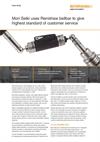Mori Seiki uses Renishaw ballbar to give highest standard of customer service
Mori Seiki Group is acknowledged as one of the world's leading designers and manufacturers of high specification machine tools, having delivered more than 185,000 units worldwide since its foundation in 1948.
Mori Seiki recognises, however, that simply offering machine tools does not provide customers with the full support for their production activities that they are looking for. In order to provide support service to the same high level, Mori Seiki has established a worldwide support system with over 400 dedicated employees located around the globe.
With an established reputation for offering the highest possible level of service Mori Seiki has 2 parts & service centres in Japan, another 5 located in Europe and USA, and 3 in Asia. These provide full support to the 44 technical centres in Japan and a further 57 around the world, where highly trained service staff are on call to ensure immediate customer response.
For its latest business strategy called “Global One”, to improve the service level to customers even further, Mori Seiki is putting added emphasis on ensuring and maintaining greater machine accuracy. A vital element in achieving this goal is widespread use of the Renishaw QC10 ballbar.
The QC10 ballbar is an internationally recognised system for diagnosing the positioning performance of machine tools. Before Mori Seiki started using the QC10 ballbar, machine performance was verified by measuring a test component machined by each machine. This was a valid test but one that required considerable time and experience to interpret the results (mis-diagnoses were not uncommon).
The QC10 ballbar is now the chosen tool for use both at the Mori Seiki factory and by service and technical centres around the world. It is a highly portable system, simple to use and with a quick test providing very powerful information about the machine's performance.
Equally important, with QC10's diagnostic software, machine errors such as backlash and servo mismatch are assigned a value and reported for each axis so that even operators with minimal experience can interpret the results reliably and consistently. Using the QC10 to compare machine accuracy at different feed rates, clockwise and anticlockwise, overall machine positioning performance can be easily verified.
A very flexible tool
Mori Seiki now routinely tests its machines prior to shipment with a QC10 to ensure the highest performance – any machines which fall outside specification are compensated quickly and effectively based on the results of the QC10 analysis. Compared with Mori Seiki's traditional method of machine verification, the QC10 allows full compensation in a fraction of the time. The QC10 is also used to test new machines after installation at the customer's premises as the transport and installation process can cause changes to the machines performance. Finally, the QC10 ballbar is increasingly used as a tool for Mori Seiki Technical Centre staff to help in their service work. In this application it helps to give a quick diagnosis and so speeds up repair and maintenance and gives the customer confidence that his machine is meeting its specified performance.
An indispensable after-sales tool
In summary it is clear that the Renishaw ballbar is increasingly important to Mori Seiki's customer support activities. Over the last two years they have taken delivery of over thirty QC10 systems worldwide to ensure that their global customers receive top class machines combined with top class service. More recently Mori Seiki has upgraded several systems for the new QC20-W wireless ballbar which offers even further advantages in use.
Background
The Renishaw ballbar test involves running a CNC program on the machine tool to trace out a circle of specified radius. The ballbar is coupled between the machine spindle and bed with special magnetic ball and cup mountings. As the machine describes the programmed circle, the ballbar monitors the radius of this circle, with deviations from the ‘perfect' circle recorded by the dedicated Ballbar 20 software. How well the machine follows the circular path is an indicator of the machine's positioning performance, and the Renishaw software is able to identify 19 separate error sources and calculate how much of the total error is contributed by each of these.

